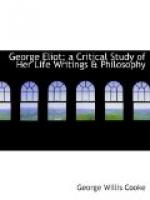Her father’s health becoming very poor, Marian spent the next two or three years in the care of him. She read to him most of Scott’s novels, devoting several hours each day to this task. During this period she made a visit to the Isle of Wight, and there read the novels of Richardson. Her father died in 1849, and she was very much affected by this event. She grieved for him overmuch, and could find no consolation. Her friends, the Brays, to divert and relieve her mind, invited her to take a continental tour with them. They travelled extensively in Belgium, Germany, Switzerland and Italy. Her grief, however, was so excessive as to receive little relief, and her friends began to fear the results. On their return to England they left her at Geneva, where she remained for nearly a year. After some months in a boarding-house near Geneva she became an inmate of the family of M. d’Albert Durade, a Swiss water-color painter of some reputation, who afterwards became the translator of her works into French. She devoted the winter of 1849-50 to the study of French and its literature, to mathematics and to reading. Her teacher in mathematics soon told her that she was able to proceed without his aid. She read Rousseau and studied the French socialists. M. Durade painted her portrait, making a remarkable picture. The softness of the clear blue eyes, in which is expressed a profound depth of thought, is one of its characteristics. M. Durade accompanied her to England in the spring of 1850, and she went to live with her brother, where she remained for a few months. The old family differences about religion had alienated the brother and sister so far intellectually that she accepted an invitation from the Brays to find a home with them. Her sadness and grief continued, and her health was not good. Her fits of nervousness and of tears were frequent, but her studies continued to occupy her mind. She delighted to converse with Mr. Bray, and other persons of earnest thought had their influence on her mind. Among these was George Dawson, the famous preacher who cut himself loose from all denominations.
II.
TRANSLATOR AND EDITOR.
It was while living at Foleshill, and amidst the intellectual influences of awakening radicalism, that Marian Evans undertook her first literary labor. This was the translation of the Leben Jesu of David Strauss. A book so daring in its interpretations of the origin of Christianity excited much attention, and especially among those who had broken away from the old religious beliefs. The work of translation was at first undertaken by Miss Brabant, who soon married Charles Hennell. Then the task was taken up by Marian Evans, who gave three years to it, renewing her Hebrew studies for the purpose, and the book was published in 1846. The work was thoroughly done, so much so that Strauss complimented the translator on its accuracy and correctness of spirit. Concerning




